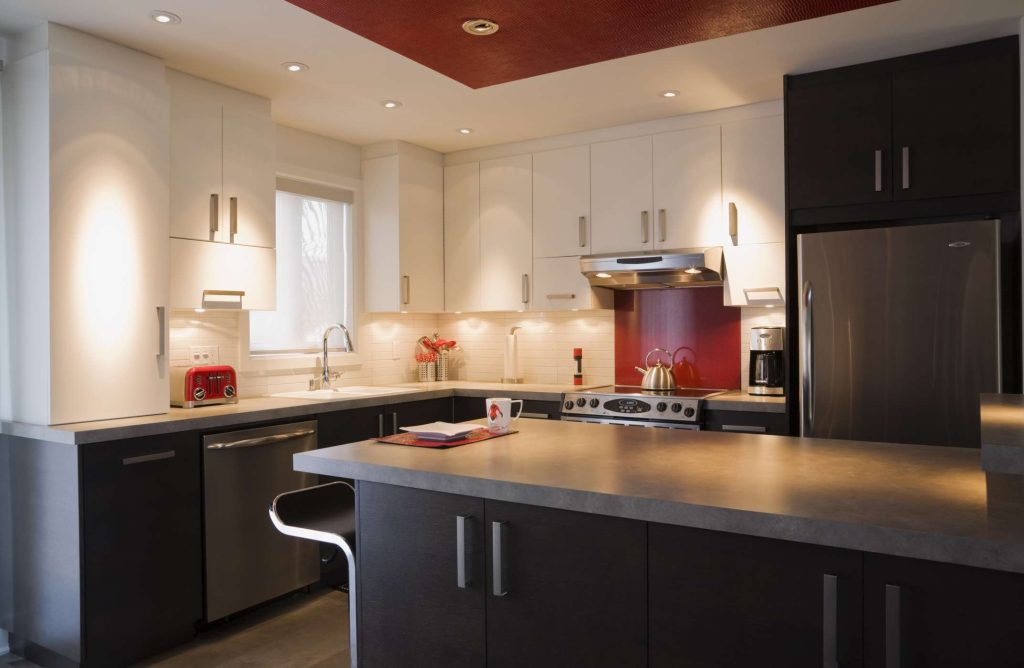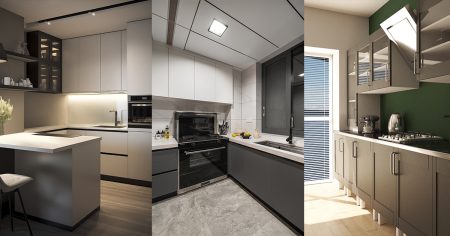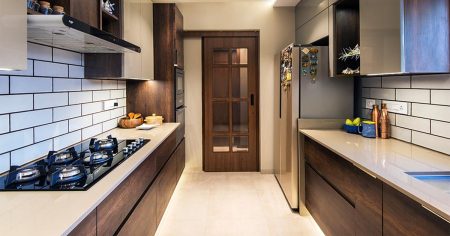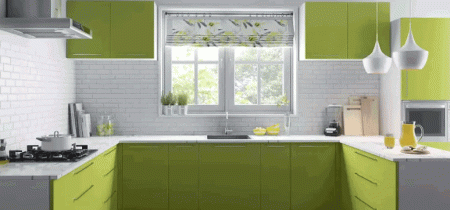Kitchen ceiling lighting requires more planning than other types of rooms. With most rooms in your house, you are trying to light up the room in general. Then, when you need to light up specific areas of these rooms, such as reading places, sewing machines, tool shop areas, eating spots, and so on, it is easy enough to add a work light or a floor or table lamp.
In the kitchen, it’s a different matter. Floor lamps have no place in a kitchen, and only in very rare cases will a table lamp work. So, kitchen ceiling lighting often needs to perform two functions at the same time: general lighting or work lighting.
Kitchen General Lighting vs. Work Lighting
- General Lighting: Sometimes called ambient lighting, this is lighting that is powerful enough to illuminate the entire kitchen area.
- Work Lighting: Sometimes called task lighting, these are lights that illuminate small, specific zones, such as islands and countertop prep and cooking areas.
Some types of kitchen ceiling light fixtures are good for general lighting, and others are good for work lighting, but none do both very well. This means that you often have to use different types of lighting to brighten both the general area and your work zones.
Types of Kitchen Lighting
Recessed Lighting
The classic solution to the kitchen lighting problem is recessed lighting. These are sometimes called can lights. With popular diameters of 4, 5, and 6 inches, recessed lights provide more than enough illumination to certain required areas of the countertop or kitchen island. But one problem with recessed lighting is shadowing. Recessed lights point down, and anything in the path of their light, be it a wall cabinet or a person working at the counter, creates a shadow below the obstruction.
The main advantage of recessed lights is that they’re flush to the ceiling and don’t occupy physical or visual space. However, this creates a drawback: there is no light that is cast onto the ceiling, which helps brighten the space.
Older recessed light fixtures also were notorious energy-wasters because they let room heat escape into the attic. But today’s AT (airtight) and IC (can be covered with insulation) fixtures don’t come with the same energy penalties.
-
Low profile
-
Very little visual distraction
-
Compatible with a variety of kitchen styles
-
Some types are major energy-wasters
-
Some types of recessed lights cannot be covered with attic insulation
Track Lighting
Track lighting provides good lighting for the kitchen and has risen in popularity in the last several decades. Track lighting has many of the same good qualities of recessed lighting, with fewer of recessed lighting’s flaws. Track lighting is installed on the surface of the ceiling, and individual light fixtures along the track can be moved easily wherever needed. Also, these individual fixtures can be added or removed if you need more or less light.
Track lights have much of the same shadowing problem as recessed lights. But because track lights can be moved, it is possible to reposition a light either forward or backward to minimize shadowing.
One thing to watch out for is low-voltage track lighting that uses ultra-bright, energy-hungry halogen bulbs. Track fixtures that use energy-efficient LED bulbs use much less energy, produce less heat, and (like halogens) can be small and still produce a lot of light.
-
Easy to reposition lights
-
Simple to add or remove lights
-
Low voltage light fixtures available
-
Visual impediment
-
Passes in and out of style
Flush-Mount or Ceiling Fixtures
Flush-mount ceiling fixtures are solid performers for general illumination. The best types shine light in all directions, including up toward the ceiling, flush-mount ceiling fixtures are great when you first enter a room. You flip the switch and suddenly you can see where you’re walking.
On the other hand, they don’t do much to illuminate the counter spaces. They also don’t offer focused or adjustable light, as track fixtures do. Since code requires lighting that you can operate by a switch when entering a room, it’s never bad to have a ceiling light available for this use.
-
Quick way to illuminate room when you first enter
-
Satisfies code requirements
-
General room illumination only
-
Counters may be left in shadow
Hanging Pendant Fixtures
One answer to the quandary of kitchen ceiling lighting is to install hanging pendant light fixtures. Hanging pendants bring the lights down to just above head level and are often vertically adjustable. Hanging pendants can be fixed in place or can be inserted into track lighting tracks.
Go sparingly with kitchen pendant lights. Recessed lights can be multiplied almost endlessly because they are mounted flush with the ceiling and are not very noticeable. Because pendant lights are hanging down, adding more than three or four begins to make the kitchen look cluttered.
If your pendant lights are spaced out intelligently, they will adequately illuminate most work surfaces. The critical areas they can’t reach are the counter spaces under wall cabinets.
-
Good task lighting
-
Excellent way to light a kitchen island
-
Visual impediments
-
Can be a physical obstruction
Undercabinet Lighting
No matter what type of ceiling fixtures you use, you’ll probably need some task lighting that shines directly down from the wall cabinets. This is the best task lighting because there’s nothing to create shadows, and the light can be very bright and focused without casting harsh light into the main kitchen area.
Undercabinet fixtures are sleek and essentially invisible once they are installed. Choose LED fixtures for the best lighting performance and energy efficiency.
-
Invisible when installed
-
No shadows on work area
-
Tiny, focused light
-
Illuminates only countertop area
Read the full article here














